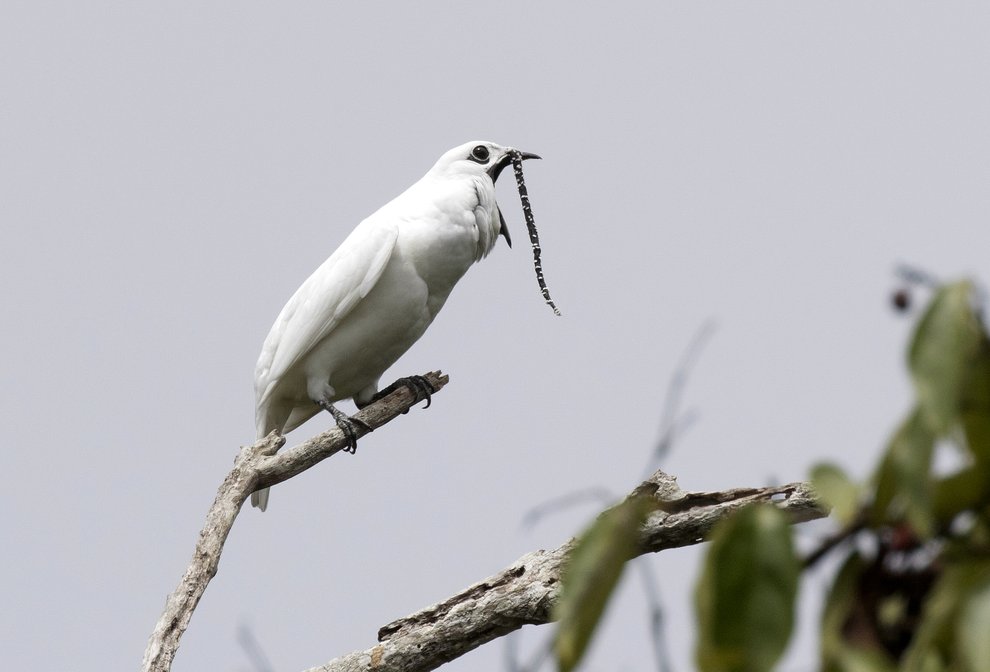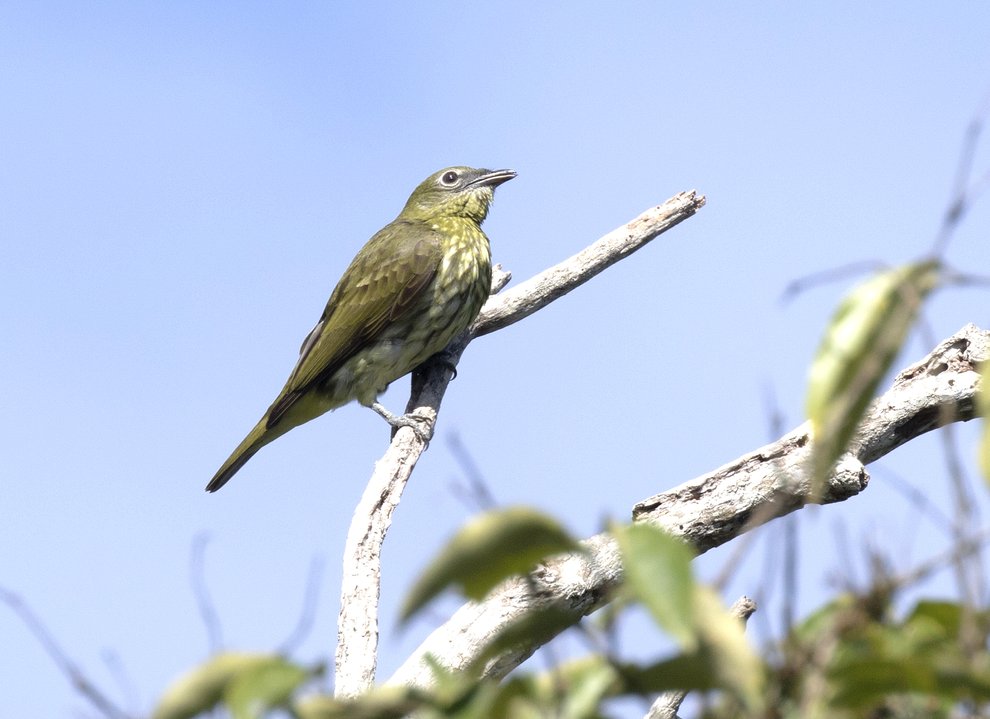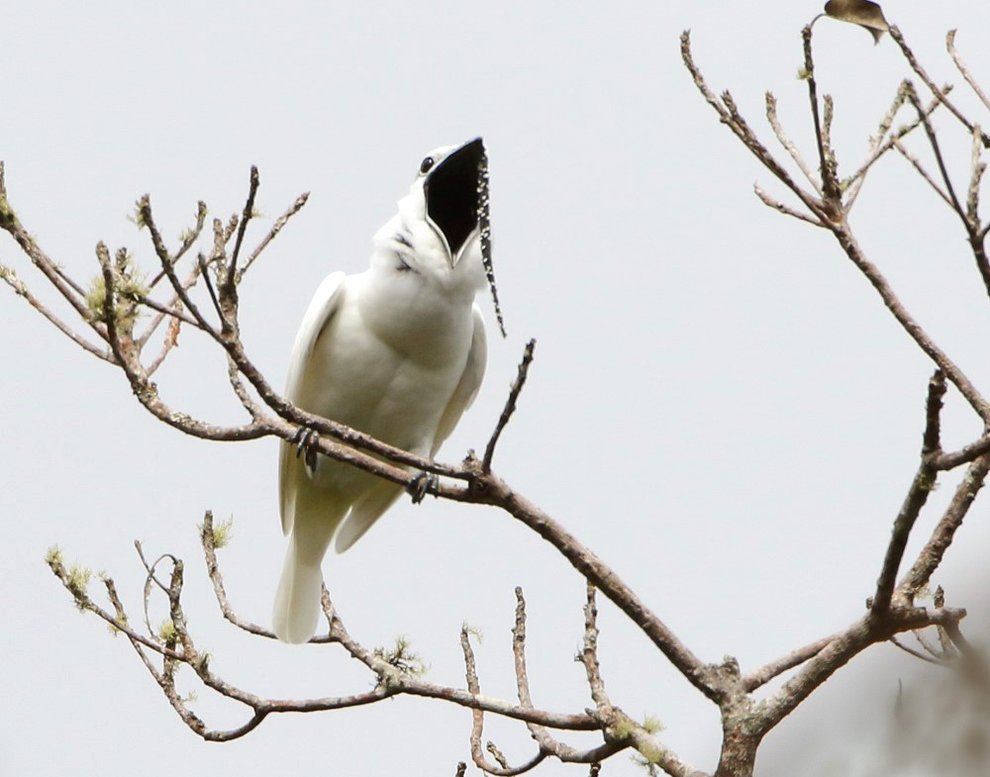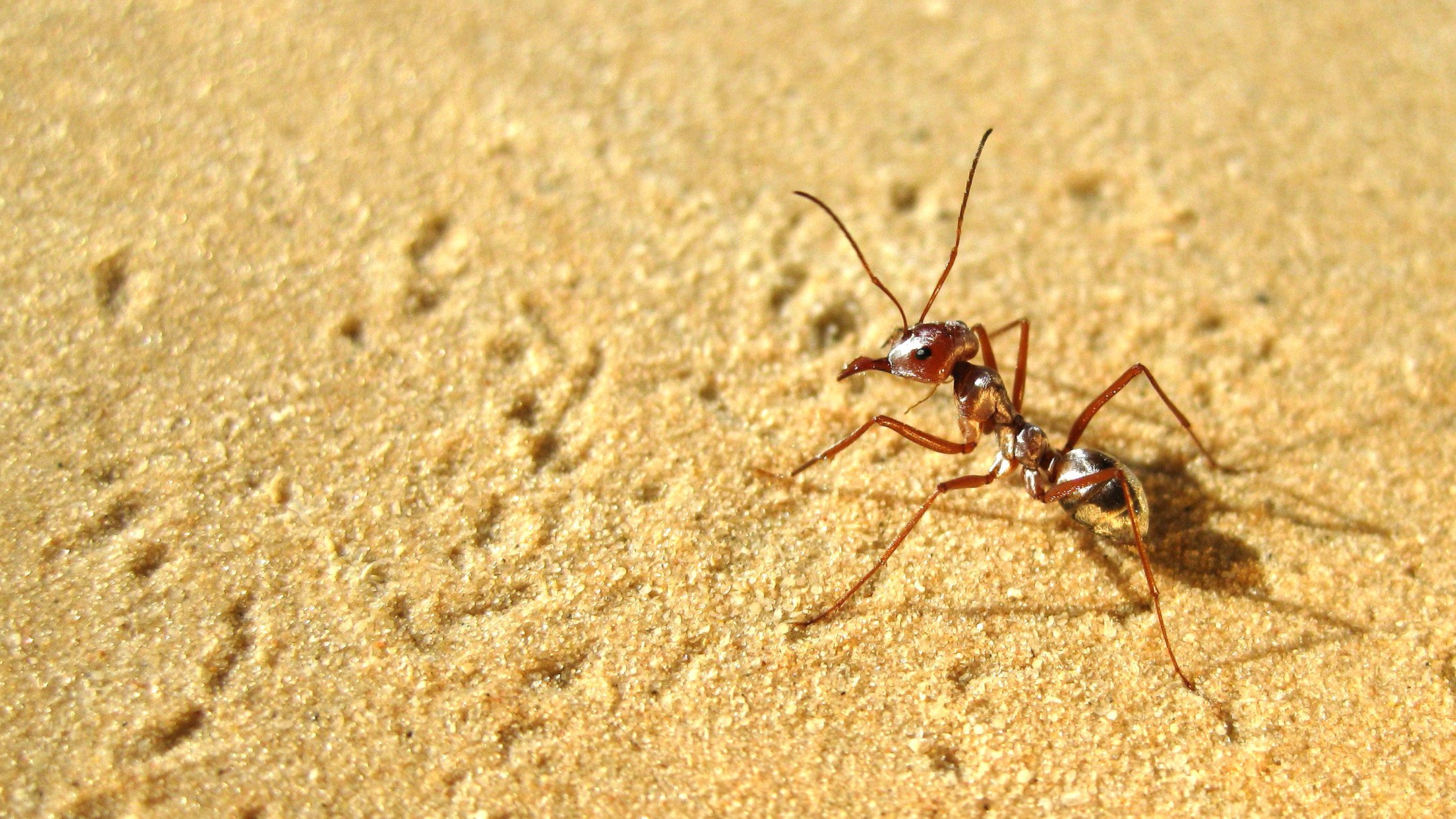World’s loudest bird flirts by screaming in your face
Researchers aren’t sure how these birds maintain this deafening mating ritual without damaging their hearing.

A male white bellbird with its bill open, just before singing. Its black and white wattle—a fleshy growth—hangs loosely over its beak. Image Credit: Anselmo d’Affonseca
The language of love is nothing if not subtle and complex. To woo potential mates, some species will whisper sweet nothings, sing a soft serenade, or even grunt a gentle come-hither call.
But male white bellbirds (Procnias albus) aren’t here for your politeness and pleasantries. When they’re looking to couple up, these brightly plumed boys will sidle up real close to their ladies, inhale deeply, and scream their heads off—to the deafening tune of 115 decibels.
“That’s like having your head in a speaker at a rock concert,” says Mario Cohn-Haft, an ornithologist at the National Institute of Amazonian Research in Brazil.
As a mating strategy, it’s forward, to say the least. But it seems to work fine for the bellbirds, according to Cohn-Haft and his colleague Jeff Podos, a bioacoustician at the University of Massachusetts Amherst. The astounding acoustic feat, reported today in the journal Current Biology, earns these boisterous birds the title of loudest recorded song in the avian world—and may even make them a top contender among all land animals.
“Right now, I can’t think of anything louder,” says Elizabeth Derryberry, an animal communication expert at the University of Tennessee, Knoxville who wasn’t involved in the study. “There can be hearing damage at this point.”
Cohn-Haft, who’s spent decades cataloguing avian diversity in the Amazon, has long been privy to the piercing, alarm-like anthems of the white bellbird. But it wasn’t until 2017, during an expedition into a particularly mountainous region, that he was able to get up close and personal with the birds’ impressive pipes. While prepping a bellbird specimen in the field, he was struck by its unusually robust abdominal muscles and sturdy ribcage.
Most birds maintain only scant musculature to keep light for flight, he explains. But the bellbird in his hands, he recalls, was absolutely ripped. “It had a washboard stomach,” he says. “It was really impressive, like a bodybuilder. And I thought, ‘That’s obviously some kind of adaptation for producing loud sound.’”

Male white bellbirds can open their bills wide enough to "swallow a golf ball," says Jeff Podos of UMass Amherst. The flared opening of their mouths might act a bit like the end of a trombone, amplifying the sound that emerges. Image Credit: Anselmo d’Affonseca
Cohn-Haft sent photos of the bird’s super-shredded physique to Podos, whose interest was instantly piqued. The next year, the pair ventured back into the Amazon, this time toting bags of sensitive recording equipment to measure the birds’ auditory output.
Historically, getting good measurements of volume hasn’t been an easy thing to do, Derryberry says. Until fairly recently, the technology wasn’t up to snuff. And out in the field, sounds can get muffled or warped by obstacles between animal and receiver if the data aren’t collected carefully.
But Podos and Cohn-Haft did things right, Derryberry says. With a state-of-the-art recording device in hand, the researchers embarked on a rigorous two day hike up the side of a remote mountain in northern Brazil. When they got within earshot of the treetop-perching bellbirds, they switched the machine on.
White bellbirds are about the size of a morning dove and weigh just half a pound apiece. But they stuff a lot in a small package: These birds, Podos says, can belt out notes roughly comparable in volume to the bellows of bison and the hoots of howler monkeys—brawny, big-mouthed mammals many times their size.
All in all, the researchers recorded more than 154 white bellbird songs, which fell into one of two categories: one very loud, and one very, very loud. The “quieter” ones were more common, and comparable in volume to those produced by the screaming piha (Lipaugus vociferans)—another Amazonian species known for a distinctive, three-part wolf whistle that, until now, was considered the loudest bird song ever documented. But every once in a while, the bellbirds upped their game, blaring out another tune with triple the sound pressure (an objective measure of a noise’s intensity) of the piha’s signature scream.
“You can hear these birds a mile away,” Cohn-Haft says.
These sonorous shenanigans all seem to be in service of sex. On several occasions, Podos and Cohn-Haft spotted females, drawn in by the acoustic stylings, joining males on their perches—presumably to get a better sense of the man behind the melody.
At this point, Podos say, you might expect the vocal braggadocio to grind to a halt. Instead, the females’ arrival prompted males to bust out the loudest parts of their repertoire, even dramatically swiveling mid-song to blast a final, emphatic note “right in her face,” Podos says.
Cohn-Haft can’t imagine this is a terribly pleasant experience. The females do back up a bit, he says. But they don’t peace out completely, often staying within a few feet of the male—well within the hot zone.

A female white bellbird. Unlike males, females have camouflaging plumage. They also lack wattles and don't sing. Image Credit: Anselmo d’Affonseca
“That’s where all the questions start,” Cohn-Haft says. It’s still unclear why the females are willing to endure the din, or how (even if) either party manages to escape the interaction with their hearing intact. Such over-the-top grandiosity can also make you conspicuous to predators, and even take a physiological toll: The louder the birds’ songs were, the shorter they got.
But something about the clang and clamor made this trait worth keeping around—so much so that it evolved in an extreme form, almost like the auditory version of a peacock tail, Derryberry says.
One possibility is that the songs help advertise males’ physical prowess, says Natalia García, an acoustic communication expert at the Cornell Lab of Ornithology who wasn’t involved in the study. Another theory, suggested to Podos by a colleague, is that the birds are intentionally trying to temporarily deafen females to the alluring songs of other males.
Whatever the reason, Derryberry says, “I guess these females like being shouted at.”

When male white bellbirds open their mouths, "it’s like an enormous black hole has opened up in this white blob," says Mario Cohn-Haft of the National Institute of Amazonian Research in Brazil. Image Credit: Anselmo d’Affonseca
Podos and Cohn-Haft both express concern about being able to address these questions and more before time runs out. As humans continue to impinge on the natural world, fragile habitats—and the vulnerable species that reside in them—are declining worldwide.
That includes parts of the Amazon, where the ballads of white bellbirds reverberate through the trees. Despite a long history of birdwatching, García points out, it took humans until now to document just how weird and wonderful these creatures truly are. There’s surely more, she says, that’s been overlooked.
“It’s overwhelming, thinking of all the biodiversity we’re losing,” she says. “There are species we won’t even know we’re losing before they’re gone.”




